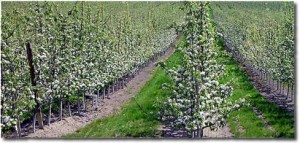
The orchard management section of this website covers a broad range of practices designed to maximize production of high quality fruit and increase grower profitability. The type of production system that will be used, whether organic or conventional, needs to be considered before developing a new orchard site. Decisions on crop varieties, site location and preparation, and water availability, need to be made while establishing a tree fruit site. The pages in this section provide information and resource links for orchard establishment, soils and nutrition, pruning and training systems, irrigation management, orchard floor management, pollination, crop load management, harvest, and automation and mechanization.
Pages within the Orchard Management Section
Organic Production
An introduction to organic production and sustainable farming can be found on this page along with reference links to more in-depth information about current research, organic certification, orchard establishment, insect pest management, disease management, tree fruit nutrition, weed control, tree training systems, packing and storage, vertebrate pest management, and food safety. Additional resource links are also provided.
Orchard Establishment
This page covers all the topics important to orchard establishment including: Orchard site selection, soil conditions, replant site considerations, economics, variety and rootstock selection, orchard systems and designs, and crop protection. Additional resource links related to orchard establishment topics are also provided.
Soils & Nutrition
A healthy soil food web is vital to fruit tree nutrition and productivity. This page presents useful information about soil properties and how to establish healthy orchard soils. We’ve also included many helpful soil-related resource links.
Environmental Stress
Fruit trees grown in Washington state are frequently exposed to environmental stresses that impact their health and production. This page will cover the most common problems and address ways to protect your trees and fruit.
Pruning and Training Systems
Fruit trees are pruned for a number of reasons including: tree architecture and size, sunlight infiltration, air circulation, strength, production, and tree health. Fruit tree training helps develop strong tree architecture that can support crop loads, and bring young trees into early production. This page offers current information and resource links on fruit tree pruning and training systems.
Irrigation Management
Fruit trees require adequate moisture to maintain growth, take up nutrients, and produce high quality fruit. Choosing the right irrigation system to deliver the appropriate amounts of water is essential. A brief discussion of orchard irrigation and useful resource links are provided on this page.
Orchard Floor Management
Orchard floor management decisions impact the health of your trees along with the overall orchard productivity and fruit quality. Topics such as orchard floor sanitation, use of cover crops, weed management, and how temperature and sunlight affect the orchard floor are the topics discussed on this page. Additionally, you will find relevant resource links for presentations, articles, and websites regarding orchard floor management.
Pollination
Pollination timing and availability of compatible pollen are key to fruit production. Bloom timing charts and pollinizer choices for apple, pear, and sweet cherry are provided here. There is also a separate subpage about factors affecting pollination by Honey Bees including foraging behavior, amount and placement of colonies, and how to protect them from pesticides.
Crop Load Management
Managing crop load is important for setting quality fruit and the heath of the tree. The rationale for this is presented here along with ways to address the issue. Multiple references and resources are also provided on this page.
Harvest
Harvest timing for tree fruit crops varies based on the fruit type and variety. Various fruit maturity-testing methods are used to help determine when fruit are ready for harvest. Crop-specific harvest information and resources can be found here.
Automation & Mechanization
“Technologies must make producers money by either increased productivity that results in a lower per unit cost; or increased fruit quality that result in a higher dollar return.” This is the guiding principle of the researchers associated with the WSU Center for Precision and Automated Agricultural Systems (WSU-CPAAS), located at the WSU Irrigated Agriculture Research and Extension Center (IAREC) in Prosser, WA. For more about this and a link to the CPAAS Yearbook, visit this page.
